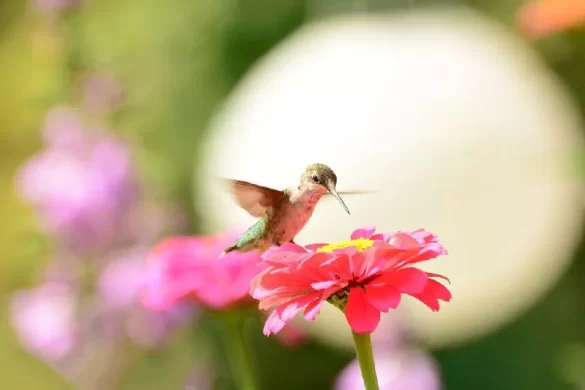Hummingbirds are fascinating creatures known for their vibrant colors, rapid wing beats, and ability to hover in mid-air. These tiny birds have a voracious appetite for nectar-rich flowers, making them important pollinators in many ecosystems. Among the diverse array of flowering plants available to hummingbirds, geraniums (Pelargonium spp.) are often considered an attractive option for gardeners. In this article, we will delve into the question: Do hummingbirds like geraniums? We will explore the characteristics of geranium flowers, examine the nectar content, and discuss the factors that attract hummingbirds to these popular garden blooms.
Understanding Hummingbirds’ Preferences:
Hummingbirds primarily rely on nectar as a source of energy. They possess long, slender beaks that allow them to reach deep into flowers, extracting nectar using their specialized tongues. While hummingbirds are known to be attracted to a variety of brightly colored flowers, not all flowers offer the same nutritional benefits or nectar composition. Therefore, it is essential to investigate whether geraniums meet their preferences.
Geranium Flower Characteristics
Geraniums are herbaceous perennial plants with showy flowers that come in various shades of red, pink, purple, and white. The flowers typically possess five petals arranged in a radial pattern, forming a saucer-like shape. Hummingbirds, with their long beaks and tongues, are well adapted to extract nectar from tubular or trumpet-shaped flowers. While geranium flowers do not fit this typical form, they do offer some intriguing features that may still attract hummingbirds.
The primary characteristic of geranium flowers that catches the attention of hummingbirds is their bright and contrasting colors. Hummingbirds are highly visual creatures and are especially attracted to flowers with vivid hues, especially reds and oranges. Many geranium varieties boast vibrant red or pink blossoms that can easily capture a hummingbird’s eye as they search for nectar sources.
Another appealing aspect of geranium flowers is their unique arrangement and structure. The petals of geraniums often curve backward, creating a distinctive cup-like shape that may provide a convenient landing platform for the hovering hummingbirds. This feature allows the birds to perch briefly while accessing the nectar, making geraniums more accessible and enticing as a food source.
Nectar Content
One crucial factor influencing hummingbird preferences for specific flowers is the nectar content. Nectar serves as the primary energy source for hummingbirds, providing them with the fuel necessary to sustain their high metabolic rate. While some flowers produce copious amounts of nectar, others may contain lower quantities or lack sufficient quality.
In the case of geraniums, the nectar production varies among different species and cultivars. Some geranium varieties produce nectar in moderate amounts, while others may have less nectar available. Additionally, the sugar concentration in geranium nectar tends to be lower compared to other hummingbird-favored flowers like trumpet vines or salvias. Despite these variations, hummingbirds have been observed visiting geraniums to access their nectar, indicating that they consider the flower a viable food source.
Factors Attracting Hummingbirds to Geraniums
Apart from color and nectar content, there are several other factors that may contribute to hummingbirds’ attraction to geraniums:
Availability: Geraniums are popular garden plants cultivated in a wide range of regions. The widespread presence of geraniums in gardens across North America and Europe provides hummingbirds with ample opportunities to encounter and develop preferences for these flowers. Familiarity and availability play significant roles in attracting hummingbirds to specific plant species.
Flowering Period: Geraniums often produce an extended blooming period, with flowers appearing from spring through fall. This extended availability of nectar-rich flowers makes geraniums an attractive option for hummingbirds seeking reliable food sources throughout the season. The continuous supply of nectar may encourage hummingbirds to frequent geraniums even if individual flowers contain relatively less nectar.
Competition with Other Pollinators: Hummingbirds are known to be territorial when it comes to feeding on nectar sources. While geraniums may not be their first choice, competition with other pollinators, such as bees or butterflies, could drive hummingbirds to explore alternate flower options, including geraniums.
Proximity to Shelter: Hummingbirds require safe perching spots and nearby shelter to rest between feedings. Gardeners who strategically place geraniums near trees, shrubs, or other suitable perching areas make their gardens more attractive to hummingbirds. The presence of shelter in close proximity to nectar-rich flowers like geraniums can create an appealing habitat for these birds.
Conclusion
While not the most traditionally shaped flowers for hummingbird attraction, geraniums possess several qualities that make them appealing to these tiny avian visitors. The bright colors, unique petal arrangement, extended blooming period, and availability of geraniums contribute to their appeal as a potential food source for hummingbirds. Despite variations in nectar content, observations suggest that hummingbirds do visit geraniums to access the available nectar. Therefore, gardeners looking to attract hummingbirds to their outdoor spaces might consider incorporating.


 Facebook
Facebook  Instagram
Instagram  Youtube
Youtube 